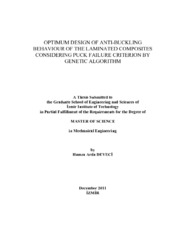Please use this identifier to cite or link to this item:
https://hdl.handle.net/11147/3167Full metadata record
| DC Field | Value | Language |
|---|---|---|
| dc.contributor.advisor | Artem, Hatice Seçil | en |
| dc.contributor.author | Deveci, Hamza Arda | - |
| dc.date.accessioned | 2014-07-22T13:51:01Z | - |
| dc.date.available | 2014-07-22T13:51:01Z | - |
| dc.date.issued | 2011 | en |
| dc.identifier.uri | http://hdl.handle.net/11147/3167 | - |
| dc.description | Thesis (Master)--Izmir Institute of Technology, Mechanical Engineering, Izmir, 2011 | en |
| dc.description | Includes bibliographical references (leaves: 71-73) | en |
| dc.description | Text in English; Abstract: Turkish and English | en |
| dc.description | x, 77 leaves | en |
| dc.description | Full text release delayed at author's request until 2015.01.14 | en |
| dc.description.abstract | In recent years, fiber-reinforced composite materials have been increasingly used in engineering applications due to their advantages such as strength and weight reduction. Determination of the buckling load capacity of a composite plate under in-plane compressive loads is crucial for the design of composite structures. Accordingly, in this thesis, optimum designs of anti-buckling behavior of 64-layered carbon/epoxy composite plates, which are simply supported on four sides and subject to biaxial compressive in-plane loads, are investigated considering Puck failure criterion by using genetic algorithm (GA). The plates are taken to be symmetric and balanced with continuous fiber angles in the laminate sequences. Critical buckling load factor is taken as objective function and fiber orientations are taken as design variables. The critical buckling load factor is maximized for various loading cases and plate aspect ratios. The optimum designs obtained are controlled layer by layer using Puck failure criterion. A comparison between continuous and discrete plate (laminate in which the orientation angles are limited to the conventional orientations) designs is performed in order to show the reliability of continuous plates. The optimization of 48-layered composite plates has been performed in order to be compared with 64-layered composite plates. The optimum designs considering Puck inter-fiber failure mode C has also been investigated. Finally, a comparative study between Puck and Tsai-Wu failure criteria is performed and the advantage of Puck failure criterion is shown. In conclusion, it is found that the optimum designs of laminated composites considering buckling and ply failure strength depend on loading, loading ratio and plate aspect ratio. | en |
| dc.language.iso | en | en_US |
| dc.publisher | Izmir Institute of Technology | en |
| dc.rights | info:eu-repo/semantics/openAccess | en_US |
| dc.subject.lcsh | Composite materials--Mechanical properties | en |
| dc.subject.lcsh | Mathematical optimization | en |
| dc.subject.lcsh | Buckling (Mechanics) | en |
| dc.subject.lcsh | Laminated materials | en |
| dc.subject.lcsh | Genetic algorithms | en |
| dc.title | Optimum design of anti-buckling behaviour of the laminated composites considering puck failure criterion by genetic algorithm | en_US |
| dc.type | Master Thesis | en_US |
| dc.institutionauthor | Deveci, Hamza Arda | - |
| dc.department | Thesis (Master)--İzmir Institute of Technology, Mechanical Engineering | en_US |
| dc.relation.publicationcategory | Tez | en_US |
| item.languageiso639-1 | en | - |
| item.fulltext | With Fulltext | - |
| item.openairecristype | http://purl.org/coar/resource_type/c_18cf | - |
| item.openairetype | Master Thesis | - |
| item.grantfulltext | open | - |
| item.cerifentitytype | Publications | - |
| Appears in Collections: | Master Degree / Yüksek Lisans Tezleri | |
Files in This Item:
| File | Description | Size | Format | |
|---|---|---|---|---|
| 421286.pdf | MasterThesis | 2.05 MB | Adobe PDF |  View/Open |
CORE Recommender
Page view(s)
176
checked on Jul 22, 2024
Download(s)
124
checked on Jul 22, 2024
Google ScholarTM
Check
Items in GCRIS Repository are protected by copyright, with all rights reserved, unless otherwise indicated.